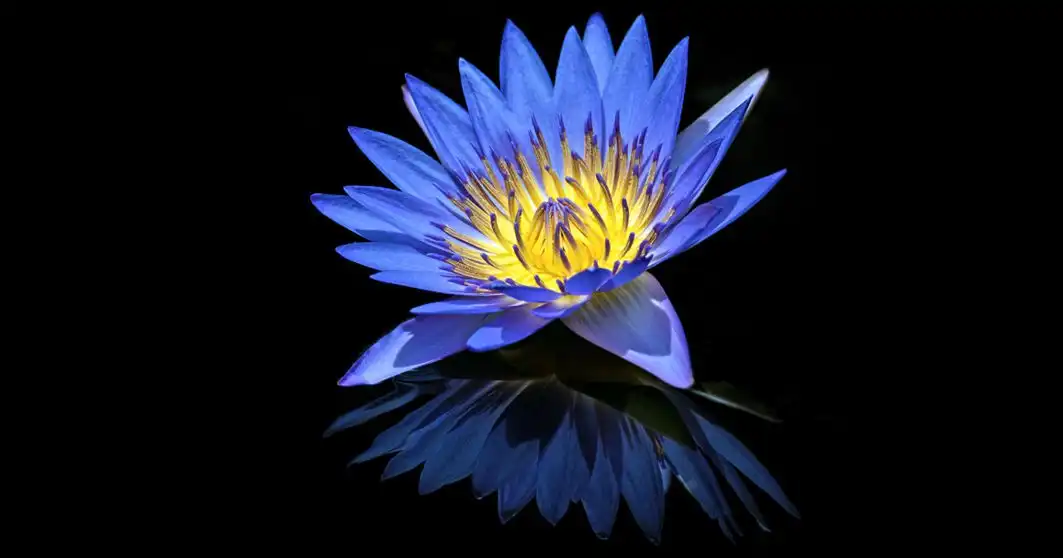
Introduction
Although Nymphaea Caerulea is commonly referred to as a blue lotus, it is actually a waterlily.
- Family: Nymphaeaceae
- Genus: Nymphaea
- Species: Caerulea, Nouchaliivar. Var. Caerulea
- Common Names: Egyptian Blue Lotus, Blue Water Lily, Sacred Lily of the Nile
This enchanting flower, the Blue Lotus, has captivated the human spirit across the annals of history, symbolizing everything from spiritual enlightenment to the sheer beauty that only nature can muster. Its story is woven through the fabric of ancient civilizations, leaving a legacy of mystery and admiration.
Ancient Origins
Rooted along the Nile, the blue lotus emerged as a spiritual icon in ancient Egypt, often linked to the sun god Ra. It was a symbol of enlightenment, adorning religious ceremonies with its presence and believed to unlock deeper meditation and joy.
Symbolism and Cultural Significance
The blue lotus represents a tapestry of meanings across different cultures, embodying purity, enlightenment, and the triumph of spirit in Hinduism and Buddhism. It’s a beacon of wisdom, knowledge, and divine beauty, deeply embedded in spiritual texts and art.
The Blue Lotus in Ancient Texts
Ancient scriptures like the Rigveda celebrate the lotus for its purity and enlightening essence, urging followers to rise above the material and seek spiritual clarity.
Influence on Art and Architecture
From ancient Egyptian artifacts to Indian temple carvings, the blue lotus has left its mark, inspiring generations with its divine grace and beauty.
Medicinal and Ritualistic Uses
Valued for its calming and aphrodisiac qualities, the blue lotus was a staple in ancient medicinal and ritualistic practices, cherished for its therapeutic benefits.
Identification
Distinguished by its vibrant blue or bluish-white petals and sweet fragrance, the blue lotus is a pollinator’s delight, with large, repellant leaves floating on water surfaces, connected to an underground rhizome teeming with nutrients.
Cultivation
Thriving in warm, sunlit conditions, the blue lotus flourishes in shallow waters, requiring regular pruning and harvesting to maintain its beauty and health.
Modern Use
Today, the blue lotus is experiencing a renaissance, celebrated in art and researched for its ancient medicinal qualities, from stress relief to enhancing memory and sexual experiences.
Herbal Medicine
As a natural remedy, the blue lotus is sought after for its ability to alleviate stress, anxiety, and promote a sense of well-being, though its most common use in Ayurveda involves a different species.
Aphrodisiac
Its reputation as an aphrodisiac persists, with some exploring its potential to enrich sexual health and increase libido.
Fragrance and Aromatherapy
The soothing aroma of blue lotus makes it a favorite in aromatherapy, lending its fragrance to candles, oils, and perfumes.
Skin Care
Packed with antioxidants, blue lotus is a boon for skincare, offering anti-aging, hydrating, and soothing benefits for a variety of skin conditions.
Teas and Infusions
The tranquil essence of blue lotus tea is cherished by many as a calming, bedtime beverage.
Smoking
Dried petals and leaves of the blue lotus are smoked or vaporized for relaxation, marking its versatility in usage.
Ceremonial Use
Still significant in spiritual practices, the blue lotus symbolizes a deep, ceremonial reverence for nature and the divine.
Conclusion
The blue lotus stands as a bridge between the natural world and humanity, a flower of profound beauty and deep symbolic meaning. It invites us to explore the spiritual, artistic, and medicinal richness of our heritage, continuing to inspire and intrigue as we delve into its mysteries. As with any traditional remedy, consulting healthcare professionals is advised to ensure its safe use.

Thank you for this informative put up on Nymphaea Caerulea, the Sacred Blue Lotus. It’s captivating to analyze about the historic and cultural importance of this historic plant. The vivid description of its use in rituals and as a herbal relaxant is intriguing. I’d love to hear extra about cutting-edge functions and the place one would possibly supply this sacred plant today. Overall, a well-researched and charming article, shedding mild on an interesting section of historical Egyptian culture.
Thank you. That is a great suggestion. I have done some further research on the ways blue lotus is being used today and updated the article.